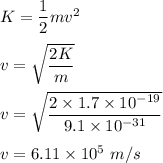
Physics, 07.04.2020 22:35 lettytinocooxmq0y
In the photoelectric effect, a photon with an energy of 5.3 × 10–19 J strikes an electron in a metal. Of this energy, 3.6 × 10–19 J is the minimum energy required for the electron to escape from the metal. The remaining energy appears as kinetic energy of the photoelectron. What is the velocity of the photoelectron, assuming it was initially at rest?

Answers: 1


Another question on Physics

Physics, 22.06.2019 16:20
Amagnetic field applies forces on: a)static chargesb)moving chargesc)water flow
Answers: 1

Physics, 22.06.2019 18:00
At the negative terminal of the battery the electron has electric potential energy. what happens to this energy as the electron jumps from the negative to the positive terminal?
Answers: 1

Physics, 23.06.2019 00:40
Asteel tube (k=50 w/mk) of inner and outer diameter di = 20mm and do=26mm, respectively, is used to transfer heat from hot gases flowing over the tube (h-hot = 200w/m2k) to cold water flowing through the tube (h-cold = 8000 w/m2k). what is the cold-side overall heat transfer coefficient uc? to enhance heat transfer 16 straight fins of rectangular profile are installed longitudinally along the outer surface of the tube. the fins are equally spaced around the circumference of the tube, each having a thickness of 2mm and a length of 15mm. what is the corresponding overall heat transfer coefficient uc? *solve for uc in both cases*
Answers: 1

Physics, 23.06.2019 13:30
Two light bulbs each having a resistance of 3ohms are connected in series to a battery marked 12 volts. how much current will flow in the circuit
Answers: 1
You know the right answer?
In the photoelectric effect, a photon with an energy of 5.3 × 10–19 J strikes an electron in a metal...
Questions

Mathematics, 08.08.2021 09:20

Arts, 08.08.2021 09:20





Mathematics, 08.08.2021 09:20



Social Studies, 08.08.2021 09:20



French, 08.08.2021 09:20

Physics, 08.08.2021 09:30



Mathematics, 08.08.2021 09:30

Mathematics, 08.08.2021 09:30

History, 08.08.2021 09:30

 .
. 






